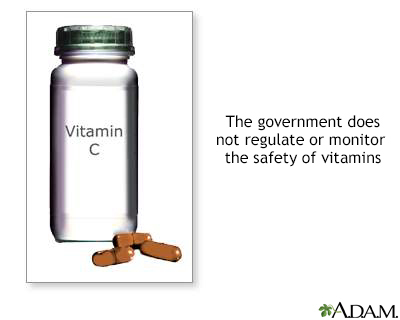Multiple vitamin overdose
Definition
Multiple vitamin overdose occurs when someone takes more than the normal or recommended amount of multivitamin supplements. This can be by accident or on purpose.
This article is for information only. DO NOT use it to treat or manage an actual overdose. If you or someone you are with overdoses, call the local emergency number (such as 911), or the local poison control center can be reached directly by calling the national toll-free Poison Help hotline (1-800-222-1222) from anywhere in the United States.
Poisonous Ingredient
Any ingredient in a multiple vitamin supplement can be toxic in large amounts, but the most serious risk comes from iron or calcium.
Additional risks are associated with large or toxic doses of calcium, vitamin D, and vitamin A.
Where Found
Many multivitamin supplements are sold over-the-counter (without a prescription).
Symptoms
Iron overdose may include vomiting, diarrhea (which may be bloody or dark), or weakness. People with severe overdoses may develop coma, low blood pressure, liver failure, lung injury, and death.
Calcium overdose can impair the functioning of the kidneys, increase the pH of the blood, and can cause nausea and vomiting, confusion or changes in thinking or mentation, itching, and in extreme cases irregular heartbeat.
Vitamin D overdose can contribute to high levels of calcium in the blood.
Vitamin A overdose can cause nausea and vomiting, dizziness, blurry vision.
Additional symptoms of a multivitamin overdose in different parts of the body may include:
BLADDER AND KIDNEYS
- Cloudy urine
- Frequent urination
- Increased urine amount
EYES, EARS, NOSE, MOUTH, AND THROAT
- Dry, cracking lips (from chronic overdose)
- Eye irritation
- Increased sensitivity of the eyes to light
HEART AND BLOOD
- Irregular heartbeat
- Rapid heartbeat
MUSCLES AND JOINTS
- Bone pain
- Joint pain
- Muscle pain
- Muscle weakness
NERVOUS SYSTEM
- Confusion, mood changes
- Convulsions (seizures)
- Fainting
- Fatigue
- Headache
- Mental changes
- Irritability
SKIN AND HAIR
- Flushing (reddened skin) from niacin (vitamin B3)
- Dry, cracking skin
- Itching, burning skin, or rash
- Yellow-orange areas of skin
- Sensitivity to sun (more likely to sunburn)
- Hair loss (from long-term overdose)
STOMACH AND INTESTINES
- Intestinal bleeding (from iron)
- Appetite loss
- Constipation (from iron or calcium)
- Diarrhea, possibly bloody
- Nausea and vomiting
- Stomach pain
- Weight loss (from long-term overdose)
Home Care
Seek medical help right away. DO NOT make a person throw up unless poison control or a health care professional tells you to.
Before Calling Emergency
Have this information ready:
- Person's age, weight, and condition
- The name of the product (ingredients and strengths, if known)
- Time it was swallowed
- The amount swallowed
Poison Control
Your local poison control center can be reached directly by calling the national toll-free Poison Help hotline (1-800-222-1222) from anywhere in the United States. This national hotline number will let you talk to experts in poisoning. They will give you further instructions.
This is a free and confidential service. All local poison control centers in the United States use this national number. You should call if you have any questions about poisoning or poison prevention. It does NOT need to be an emergency. You can call for any reason, 24 hours a day, 7 days a week.
What to Expect at the Emergency Room
Take the container with you to the hospital, if possible.
The health care provider will measure and monitor the person's vital signs, including temperature, pulse, breathing rate, and blood pressure. Symptoms will be treated. The person may receive:
- Activated charcoal, depending on the vitamin taken
- Blood and urine tests
- Breathing support, including oxygen, tube through the mouth into the lungs, and breathing machine (ventilator)
- X-rays
- ECG (electrocardiogram, or heart tracing)
- Intravenous (IV) fluids through a vein
- Laxatives
- Medicines to treat symptoms
- Medicines to remove iron from the body, if needed
- Blood transfusions (exchange transfusions), if needed
In severe cases, the person may be admitted to the hospital.
Outlook (Prognosis)
If medical treatment is quickly received, people who have iron and calcium overdoses usually recover. Overdoses of iron that cause coma or low blood pressure can sometimes be fatal. Iron overdoses can have long-term consequences to the intestines and liver, including intestinal scarring and liver failure.
Niacin flush (vitamin B3) is uncomfortable, but lasts only 2 to 8 hours. Vitamins A and D may cause symptoms when large doses are taken each day, but a one large dose of these vitamins is rarely harmful. B vitamins usually do not cause symptoms.
Gallery

References
Aronson JK. Vitamins. In: Aronson JK, ed. Meyler's Side Effects of Drugs. 16th ed. Waltham, MA: Elsevier; 2016:435-438.
Theobald JL, Mycyk MB. Iron and heavy metals. In: Walls RM, Hockberger RS, Gausche-Hill M, eds. Rosen's Emergency Medicine: Concepts and Clinical Practice. 9th ed. Philadelphia, PA: Elsevier; 2018:chap 151.